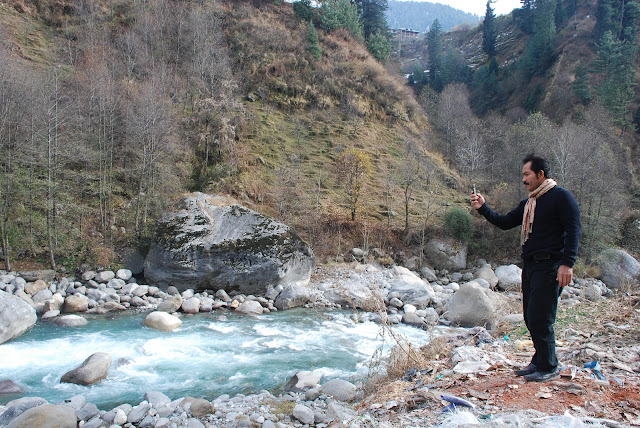One of the most impressive thing that we saw from our December 2011 trip to the northern India was it's beautiful lakes, seen from my earlier entry, the LAKES that is forming from a flow of river from the Himalayan valley. A specific flows of the river from a Himalayan valley is the "Beas River" as the name on this entry. The Beas River is a flowing river in the northern part of India, rises in the Himalayas, the central state of Himachal Pradesh and flows for about 470 km to the Sutlej River in through the Indian state of Punjab. Beas River total length is 470 km and its drainage basin is 20,303 square kilometres large, combination of small and big stream. I'm honored to share in this entry, various photos that I snapped along NH21 crossing along the Beas River.
My husband was astonished with the beautiful colors of the Beas River as I was. We've never seen such beauties before, hence we asked the driver to stop along the journey back to Delhi so that we can appreciate a little while a river's beauty complacent with it's surrounding scenery. The river was also known as Arjikuja of the Vedas (Note: Vedas is an ancient book of the Hindus) or Vipasa to the ancient Indians, and the Hyphasis to the ancient Greeks (the place was part of Alexander the Great conquests).
 |
| The source of Beas River |
It's present name, "Beas" is thought to be a corruption of the older name and the original "Vipasha" name in the Sanskrit. The river got this name, Vi-pasha, meaning the "one who removes the bondage". According to ancient texts, the river was named after the incident in the life of the sage Vasistha. It was told in the ancient book that Vasistha, aggrieved at the death of his 100 sons, tried to end his life jumping into this river, after binding himself with a rope. But as soon as the sage fell into the river, the kindly river (feminine) untied all the knots, and he was safely set on the banks. Hence, the river gained the name Vipasha in Himachal, especially called so in Indian's myths and history.
The Beas River is rising on the southern face of Rohtang Pass in Kullu district (upper Manali) at 13,326 feet above the sea-level and it traverses into the Mandi district and enters Kangra district at Sanghol (lower end) of 1,920 feet above sea-level. The Beas river joins the Satluj river at the south-western boundary of Kapurthala district of Punjab after a total course of 290 miles. The Sutlej continues into Pakistan Punjab and joins the Chenab river at Uch near Bahawalpur. The waters of the Beas and Sutlej rivers rivers are allocated to India under the Indus Water Treaty between India and Pakistan.
Another interesting story to be told is that, the Beas River marks the eastern most border of Alexander's the Great conquests to Asia in 326 BC. It was also one of the rivers which created problem in his invasion towards India. His troops mutinied here in 326 BCE, refusing to go any further as they had been away from home for almost 8 years. Alexander shut himself in his tent for three days, but when his men did not change their desires, he gave in and returned home.
I met an old Tibetan man while admiring a connecting bridge to the other side of the river. There was another Tibetan monastery and that man was part of the Dalai Lama follower who had fled into Manali. Their presence are everywhere.
In the 20th Century, the river was developed under the Beas Project for irrigation and hydroelectric power generation purposes. The second-phase Pong Dam was completed in 1974 followed by the first-phase 140 km upstream and Pandoh Dam in 1977. The Pong Dam served initially to primarily provide irrigation below Talwara but was soon developed as well for power generation of 360 MW capacity. The Pandoh Dam diverts the river through a system of tunnels and channels to the 990 MW Dehar Power Station on the Sutlej River, connecting both rivers. 3 below photos, snapped in Punjab marked the end of our Northern exploration in India. We hope we will have another opportunity going up to Leh (my dream place) and Kashmir (hubby's dream place).
















No comments:
Post a Comment